-
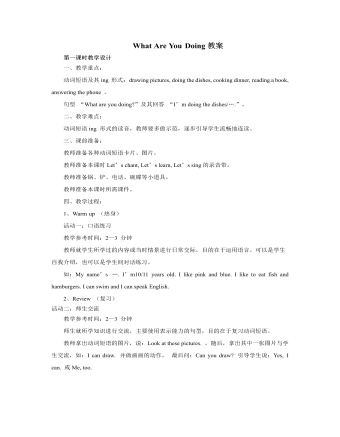
人教版新课标PEP小学英语五年级下册What Are You Doing教案
教学参考时间:2—3分钟教师让学生说出几个家庭成员名称,如:father, mother, sister, brother, uncle等,自己或让学生把单词写在黑板的一侧,再让学生说出几个动词短语的-ing形式,如:washing clothes, writing an e-mail, watching TV等,写到黑板的另一侧。学生在家庭成员名称和动词短语中分别选三至四个,自己编成一首歌谣。课后,可以让学生将创作的歌谣进行展示或举行歌谣朗读比赛。5、Consolidation and extension (扩展活动)活动十:知识扩展教学参考时间:1—2 分钟教师让学生打开书第54页Good to know 部分,了解主要国家的紧急救助电话。如:美国,英国,加拿大,澳大利亚等。教师还帮助学生了解我国的紧急救助电话号码。教师可以利用道具电话让学生做游戏。活动十一:练一练教学参考时间:2—3 分钟做本单元B Let’s talk部分的活动手册第37页的配套练习。教师讲解题目要求。教师播放录音,做Listen and number 部分练习。要求按所听内容在图上写出序号。再次播放,让学生按录音内容填空。鼓励学生自己读读所写句子。
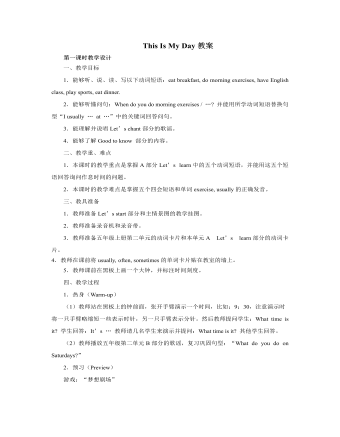
人教版新课标PEP小学英语五年级下册This Is My Day教案
学生初步了解对话内容,在描述中培养学生的语言运用能力。(2)教师让学生自己阅读本部分对话,不理解的生词和句子可以和同学或老师共同商讨。(3)教师帮助学生理解句子:“The weather report says it’s going to rain tomorrow. I can’t play football in the rain. I can’t go hiking, either. Let’s watch TV together.”出示图片:1) 晴天,Zoom在踢足球,图下显示:today;2)天在下雨,Zoom和Zip在屋里看电视,图下显示:tomorrow。与学生展开对话T:What’s the weather like today? S:It’s fine/ sunny. T:What does the weather report say about tomorrow?S:It’s going to rain.T:The weather report says it’s going to rain tomorrow.(呈现句子)(学生重复句子The weather report says it’s going to rain tomorrow.,并说出意思。)T:Can you play football in the rain?S:No,I can’t.T:Can you go hiking ?S:No,I can’t.T:In the rain, we can’t play football. We can’t go hiking, either. (呈现:either)学生跟读either,感悟单词的用法,教师讲解意思:(不......),也不...启发学生用either说两句话:In the rain, I can’t ... I can’t ..., either,从而在应用中巩固单词的读音和用法。
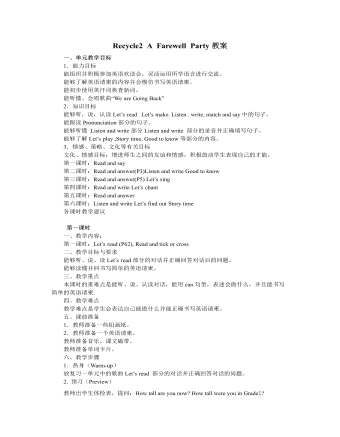
人教版新课标PEP小学英语六年级下册Recycle2 A Farewell Party教案
3. 新课呈现(Presentation) Let’s make (1)教师说:Miss White is making a book about her students. So she can remember them well.Who are the students? 请学生独立或分小组朗读四段短文,解释学生不理解的句子,然后说:There are four pictures below. Would you like to help Miss/White glue the pictures? 教师知道学生完成图文搭配的练习。 (2)教师发给每名学生一张铅画纸,说:Now please draw a picture of your best classmate. Then describe him or her.学生画一副最要好的同学的肖像,并在傍边配上对该同学的英语介绍。 学生上讲台介绍自己最要好的同学,请其他学生猜是谁,看谁说的生动又贴切,教师给予评价时注意强调第三人称单数形式的使用。 Story time 教师向学生展示Story time部分的教学挂图,指着最后一副图中的Zoom 和 Zip说 Look at the picture. Zoom and Zip are sad. They are saying goodbye to each other. Now let’s see What happened. 学生同桌之间合作阅读或是,然后教师提出问题Where is Zip going? Is this good news for zoom ? What grade is Zip going to be in? 教师放录音,学生录音跟读故事,然后再分角色朗读.
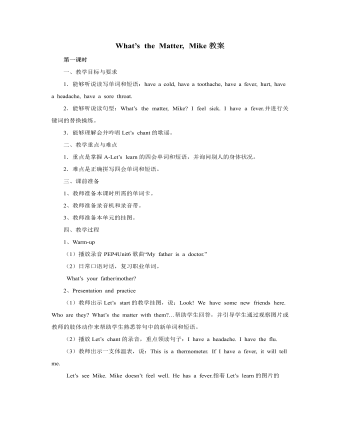
人教版新课标PEP小学英语六年级下册What’s the Matter, Mike教案
回答:She’s sad. She failed the math test.并板书:fail the math test。准备一张很糟的数学试卷,是学生了解语意。进一步教学其他短语a Chinese test, a English test,并 让学生了解pass the Chinese test, pass the English test, pass the math test. (4)教师请学生扮演Sarah,师生对话如下: T: Hello! Sarah, how are you? You look sad today. Sarah: Yes, I failed the math test. 教师接着说:I’m sorry to hear that.让学生理解意思。并引申出句子:I’m glad to hear that.让学生分角色朗读对话。 (5)Let’s check.让学生看Sarah的表情,并读两篇对话,选出正确的答案。 (6)活动名称:心理医生 活动目的:操练句型“How are you? You look…”.学生间自由组合编排对话.通过对话对学生展开情感教学,让学生理解健康的体魄和愉悦的心情的心情是一个人成功的重要因素,使学生形成良好的心理健康状态。 活动过程:A: How are you? You look bored today. B: Yes. I failed my math test. A: I’m sorry to hear that. Believe yourself. Work hard. You can pass the text next time. (7)活动名称:难忘时刻 活动目的:围绕照片上的表情展开询问和讨论.操练句型 “How do you feel? How does she/he feel?

人教版新目标初中英语七年级下册Don’t eat in class教案2篇
Don’t fight. =You can’t fight. (板书,教读)教师把这些句子板书在黑板上,并请学生大声整齐地读祈使句和“can’t”句型,并让学生注意两种句型表达形式的不同和转换,“Don’t …=You can’t…”;并对学生说:These are our school rules. (板书,教读) You can’t break the school rules. Don’t break the school rules.(板书,教读)步骤3 :Practicea. T: Now, each of the students is breaking one of these rules.Please finish 1a.学生看图,完成1a的内容,检查答案并大声朗读校规。b. 听录音,完成1b,选出四位学生都违反了哪条校规;听之前,学生要读会英文名。c. 请两位学生朗读1c部分的句型;要求学生两人一组对话表演,SA扮演外校转来新生,SB告知本校校规。(学生可经过讨论,多说出他们想到的校规,不必只限于书上;教师应给予帮助)2) 第二课时(2a~4)步骤1 :warming up of revisionT: What are the rules at your school?学生使用“can”或祈使句表达各条校规;其中老师可引出“eat in the cafeteria outside”的表达。步骤2 :Practicea.T: Christina is an exchange student. She doesn’t know the rules. Let’s listen, what activities they’re talking about?学生听第一遍时,完成2a;第二遍时,完成2b;b. 请学生领读2c部分,看着2a完成的表格,理解2c活动的要求;分成小组针对2a进行问答;

人教版新目标初中英语七年级下册Where did you go on vacation教案
句型: Where did you go on vacation? I went to summer camp.Did she go to Central Park?Yes,she did.No, she didn’t语法:一般过去时特殊疑问句、一般疑问句及肯、否定回答。课时安排4课时第一课时:Section A:la,1b,lc,2a,2b,2c 第二课时:Section A:3a,3b,4第三课时:Section B:1,2a,2b,2c第四课时:Section B:3a,3b,3c,4 and Self Check第一课时教学目标掌握描写假期生活的形容词。假期里自己所做事情的简单表达。谈论假期做的事情及当时情况。谈论假期时旅游的天气,旅游者以及食物等。教学过程一、导入播放一首英文歌曲:Let’s travel 说明:通过让学生听节奏欢快迪斯尼英语歌曲Let’s travel.引入本节课谈论的话题vacation and travel. 让歌曲使学生的思维活跃,增强课堂气氛,激发学生提高学习英语的兴趣。T:How is the trip ?Ss : It’s pretty good/ happy/exciting /relaxing/busy/dangerous/ fantastic说明:这个问题是为了操练形容词。建议让多个Ss作答。鼓励他们用不同的形容词。上述个别形容词本应在第二课时中出现,但可以在warming-up中第一次非正式出现。这些形容词也可在老师的评价语中适时出现,以加深学生对词汇的印象。
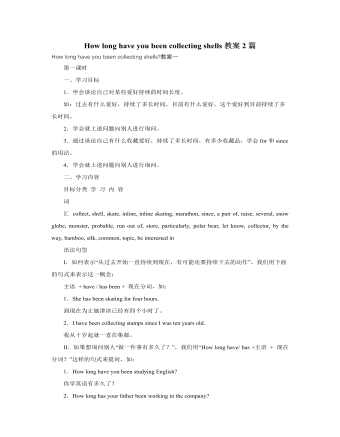
人教版新目标初中英语八年级下册How long have you been collecting shells教案2篇
Step Ⅱ Show the new words on the screen and teach the new words. Read the new words to students and ask them to repeat.Step Ⅲ 3aThis activity introduces new vocabulary and provides reading practice using the target language.In this activity first look at the four pictures.T: What can you see in the pictures?Ss: Four snow globes.T: Right. There are four snow globes in the pictures. And what are they?Ss: They are a monster, two polar bears, two penguins and a birthday cake.Write these words on the blackboard: snow globe; monster; polar bear; penguin and birthday cake. Read them to the class and ask students to repeat each one. Make sure students understand each word.Use a computer to show the E-mail message on the screen and read the message to students.Get students to read the e-mail on their own, and then draw lines connecting each snow globe and its description.Correct the answers.AnswersA line should connect each snow globe picture with the words that describe it in the letter.Step Ⅳ 3bThis activity provides writing practice using the target language.First review Activity 2a on Page 47.Then ask students to complete the message according to Activity 2a.Some partial sentences are given to students. Write about one person's collection.When students work, walk around the room checking the progress and offering help as needed.When they finish, ask some students to read their messages to the class.
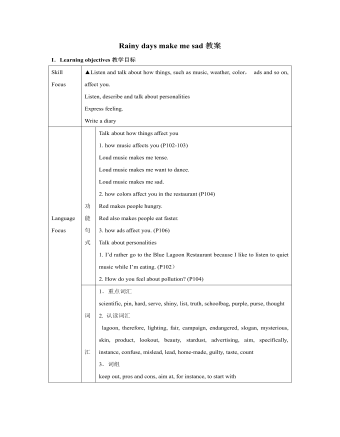
人教版新目标初中英语九年级下册Rainy days make me sad教案
1. 教材分析本单元以how do things affect you?为话题, 从颜色、天气、音乐、广告、产品等方面谈论了外界事物如何影响人的心情。要求学生掌握表达某物或某事给人带来的感觉、看法或影响等。共设计了四个部分的内容:Section A 该部分有4个模块:第一模块围绕Which restaurant would you like to go to?这一话题展开思维(1a)、听力(1b)、口语(1c)训练;第二模块围绕How does music affect you? 进行听力(2a-2b)、口语训练(2c);第三模块继续围绕how do colors in the restaurant affect you这一话题展开训练,训练形式为阅读和问题体验(3a)和小组活动(3b);第四模块仍就How do things affect you这一话题以调查的形式展开讨论。Section B该部分有4个模块:第一模块围绕产品广告对人们的影响这一话题以“配对”(1a)与“列举”(1b)两种形式展开训练;第二模块继续围绕How do things affect you? 进行听力(2a-2b)、口语对话训练(2c);第三模块围绕“Advertising”这一话题展开阅读(3a-3b)和写作(3c)训练;第四模块围绕How posters affect you这一话题以口语训练形式展开小组活动。
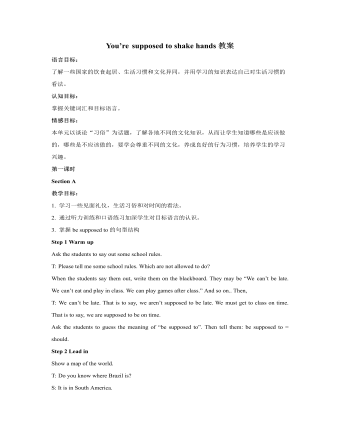
人教版新目标初中英语九年级下册You’re supposed to shake hands教案
教学目标:1. 掌握本单元一些重点词汇的写法和用法。2. 学会自如谈论餐桌礼仪。Step 1 RevisionAsk some students to retell the customs at the table in France in the passage in 3a.Step 2 Self checkPart 1. Fill in each bland with the correct word given. Students do the exercises by themselves at first. Then check the answers. Ask the students to comprehend the sentences and help them point out uses of some words, like “arrive (at / in) sw., spend time / money on sth , spend time / money (in) doing sth.”Part 2. Read about Fan Ling’s experience in a western restaurant. Understand the passage. Point out some key points in the passage.1. be / get used to doing sth. 习惯做某事2. begin with = start with 以….开头3. crowd v. 挤满,塞满 the crowd 人群 crowded adj. 拥挤的Then students discuss about how she would solve her problem. Ask some to share their stories with others.Part 3. Complete the crossword by looking at the sentences on the left. Then check the answers.

初中生物北师大版七年级下册《第14章第1节人类活动对生物圈的影响》教案
知识和技能 1.了解人类活动对生物圈影响的几个方面的实例。 2.掌握环境污染的产生及危害。 3.举例说明人类对生物圈中资源的合理利用。 过程与方法 1.能初步学会收集资料,养成良好的学习习惯,能够运用所学知识、技能分析和解决一些身边的生物学问题的能力。 2.培养学生初步具有近一步获取课本以外的生物学信息的能力。 情感、态度与价值观 1.让学生认识到环境保护的重要性,能够以科学的态度去认识生命世界,认同人类活动对生物圈的影响,形成环境保护意识,并使这种意识转变成真正的行动,培养学生保护环境的意识,增强爱国主义思想1.认同人类活动对生物圈的影响,形成环境保护意识 2.做到从实际行动出发保护环境1.采取让学生收集资料,整理资料,解疑
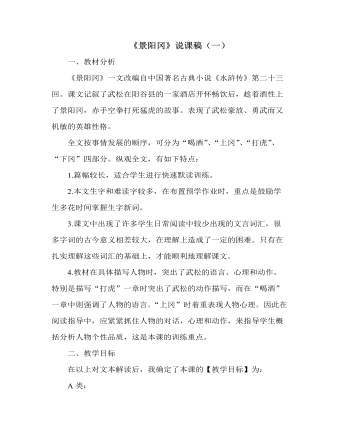
部编人教版五年级下册《景阳冈》说课稿(一)
全文按事情发展的顺序,可分为“喝酒”、“上冈”、“打虎”、“下冈”四部分。纵观全文,有如下特点:1.篇幅较长,适合学生进行快速默读训练。2.本文生字和难读字较多,在布置预学作业时,重点是鼓励学生多花时间掌握生字新词。3.课文中出现了许多学生日常阅读中较少出现的文言词汇,很多字词的古今意义相差较大,在理解上造成了一定的困难。只有在扎实理解这些词汇的基础上,才能顺利地理解课文。4.教材在具体描写人物时,突出了武松的语言、心理和动作。特别是描写“打虎”一章时突出了武松的动作描写,而在“喝酒”一章中则强调了人物的语言。“上冈”时着重表现人物心理。因此在阅读指导中,应紧紧抓住人物的对话,心理和动作,来指导学生概括分析人物个性品质,这是本课的训练重点。
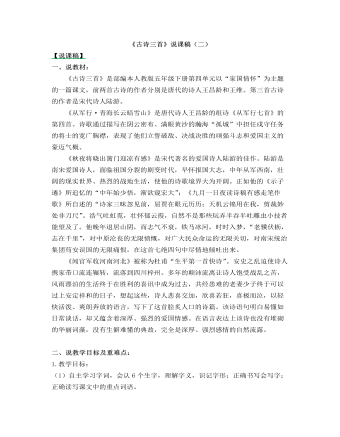
部编人教版五年级下册《古诗三首》说课稿(二)
二、说教学目标及重难点:1.教学目标:(1)自主学习字词,会认6个生字,理解字义,识记字形;正确书写会写字;正确读写课文中的重点词语。(2)有感情地朗读古诗,背诵古诗,默写《从军行》《秋夜将晓出篱门迎凉有感》。(3)借助注释和插图理解古诗的大意,并能用自己的话说出诗句的主要意思。(4)深入理解古诗内容,学会背诵古诗。理解古诗大意,体会作者的思想感情。2.教学重点:自主学习字词,理解字义,识记字形;有感情的朗读、背诵古诗,默写《从军行》和《秋夜将晓出篱门迎凉有感》;借助注释和插图理解古诗的大意,并能用自己的话说出诗句的意思;凭借语言文字注解、图片等,在反复诵读的基础上,想象诗歌所描绘的情景,体会诗人所表达的思想感情,感受诗歌的语言美和内蕴美。
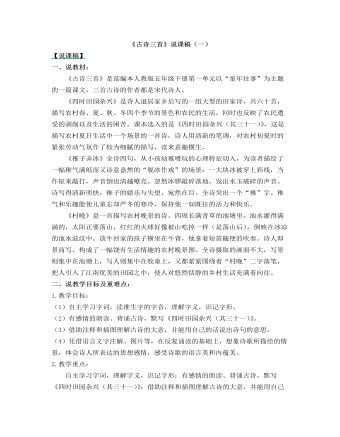
部编人教版五年级下册《古诗三首》说课稿(一)
三、说学情:五年级的学生在古诗学习中已经积累了一定的经验,对文本有独特的阅读体验。课文所描写的情景又都与儿童有关,反映儿童生活,学生也可能有着相似的亲身经历,符合学生的心理,容易引起学生情感的的共鸣,进而在阅读古诗中获得感知,加以模仿,发展想象力,锻炼学生的理解能力和语言表达能力。四、说教法和学法:1.说教法:教学中,设置情景,激发学生认知兴趣,调动学生主动学习的欲望,引导学生主动探究。使学生这一教学主体主动积极地进行语言文字的学习和探究。2.说学法:教学过程体现“以读为本”的新课标理念,教学中,始终让“读”贯穿着整个教学过程。引导学生在读中感受古诗词的优美精湛的语言文字和丰富的人文内涵;在入情入境的读中有所感悟和思考;在读中受到情感的熏陶,获得思想的启迪。
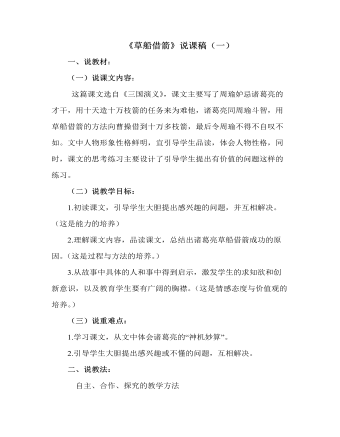
部编人教版五年级下册《草船借箭》说课稿(一)
一、说教材:(一)说课文内容:这篇课文选自《三国演义》,课文主要写了周瑜妒忌诸葛亮的才干,用十天造十万枝箭的任务来为难他,诸葛亮同周瑜斗智,用草船借箭的方法向曹操借到十万多枝箭,最后令周瑜不得不自叹不如。文中人物形象性格鲜明,宜引导学生品读,体会人物性格,同时,课文的思考练习主要设计了引导学生提出有价值的问题这样的练习。(二)说教学目标:1.初读课文,引导学生大胆提出感兴趣的问题,并互相解决。(这是能力的培养)2.理解课文内容,品读课文,总结出诸葛亮草船借箭成功的原因。(这是过程与方法的培养。)3.从故事中具体的人和事中得到启示,激发学生的求知欲和创新意识,以及教育学生要有广阔的胸襟。(这是情感态度与价值观的培养。)
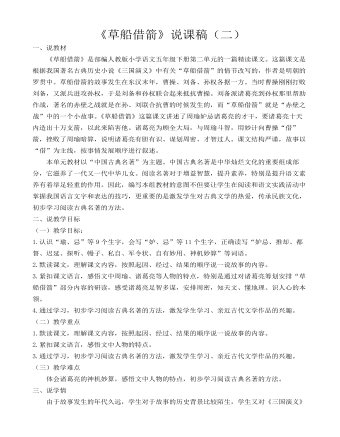
部编人教版五年级下册《草船借箭》说课稿(二)
一、说教材《草船借箭》是部编人教版小学语文五年级下册第二单元的一篇精读课文。这篇课文是根据我国著名古典历史小说《三国演义》中有关“草船借箭”的情节改写的,作者是明朝的罗贯中。草船借箭的故事发生在东汉末年,曹操、刘备、孙权各据一方。当时曹操刚刚打败刘备,又派兵进攻孙权,于是刘备和孙权联合起来抵抗曹操。刘备派诸葛亮到孙权那里帮助作战,著名的赤壁之战就是在孙、刘联合抗曹的时候发生的,而“草船借箭”就是“赤壁之战”中的一个小故事。《草船借箭》这篇课文讲述了周瑜妒忌诸葛亮的才干,要诸葛亮十天内造出十万支箭,以此来陷害他。诸葛亮为顾全大局,与周瑜斗智,用妙计向曹操“借”箭,挫败了周瑜暗算,说明诸葛亮有胆有识、谋划周密、才智过人。课文结构严谨,故事以“借”为主线,按事情发展顺序进行叙述。

部编人教版五年级下册《刷子李》说课稿(二)
二、说教学目标及重难点:1.教学目标 :(1)自主学习字词,会认“浆、傅”等7个生字,会写“浆、傅”等15个生字,理解字义,识记字形。正确读写“粉刷、刷浆、规矩、徒弟、端茶、点烟、跟在、屁股、师傅”等词语。(2)有感情地朗读课文,了解一位普通手艺人高超的技艺。(3)继续领悟并学习作者刻画人物的方法。2.教学重点:感受人物形象,体会作者抓住细节描写人物的方法。3.教学难点:领悟并学习作者刻画人物形象的方法。三、说学情:作为五年级的学生,他们已经有了一定的自学能力,有了一定的认知范围,所以我要求学生通过课前预习提前掌握文中的生字新词;通过搜集资料了解作家冯骥才;熟读课文,感受刷子李的特点。
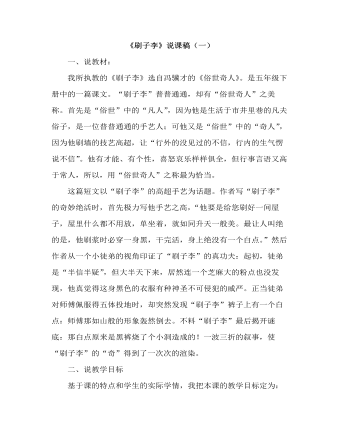
部编人教版五年级下册《刷子李》说课稿(一)
一、说教材:我所执教的《刷子李》选自冯骥才的《俗世奇人》。是五年级下册中的一篇课文。“刷子李”普普通通,却有“俗世奇人”之美称。首先是“俗世”中的“凡人”,因为他是生活于市井里巷的凡夫俗子,是一位普普通通的手艺人;可他又是“俗世”中的“奇人”,因为他刷墙的技艺高超,让“行外的没见过的不信,行内的生气愣说不信”。他有才能、有个性,喜怒哀乐样样俱全,但行事言语又高于常人,所以,用“俗世奇人”之称最为恰当。这篇短文以“刷子李”的高超手艺为话题。作者写“刷子李”的奇妙绝活时,首先极力写他手艺之高,“他要是给您刷好一间屋子,屋里什么都不用放,单坐着,就如同升天一般美。最让人叫绝的是,他刷浆时必穿一身黑,干完活,身上绝没有一个白点。”然后作者从一个小徒弟的视角印证了“刷子李”的真功夫:起初,徒弟是“半信半疑”,但大半天下来,居然连一个芝麻大的粉点也没发现,他真觉得这身黑色的衣服有种神圣不可侵犯的威严。
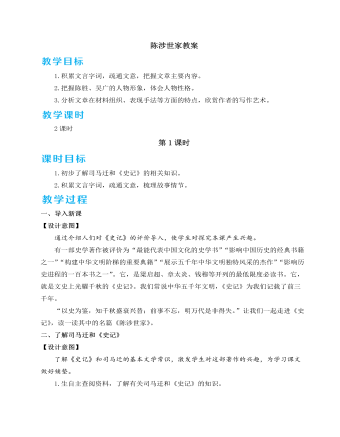
人教部编版语文九年级下册陈涉世家教案
1.王侯是一个地区的实际统治者,世代保有其国,对全国政局有一定的影响,故其传记称为“世家”。陈涉并非王侯,司马迁为什么把他归入“世家”?《史记》中人物传记分为三类,“本纪”记帝王,“世家”记王侯,“列传”记人臣,但这只是一个大略的划分,对于某些历史人物,作者有他特殊的考虑。陈涉就是一个特例。他出身低微,起义后虽自立为王,但为时仅六个月。之所以列入“世家”,是因为在秦王朝的严酷统治下首先发难,的确是非常之功。司马迁在这篇传记的最后写道:“陈胜虽已死,其所置遣侯王将相卒亡秦,由涉首事也。”可见司马迁看重的是功业,而不以成败论英雄。类似的例子有项羽,他并未统一称帝,但作者高度评价了他在反秦斗争中的领导作用,把他列入“本纪”。2.本文是长篇节选,在结构上具有怎样的特点?
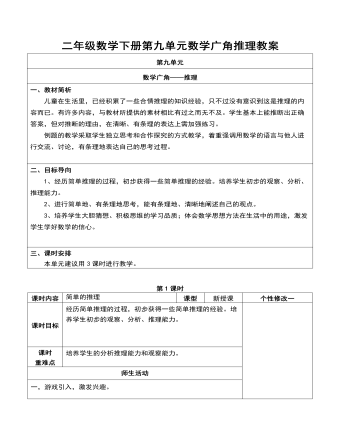
二年级数学下册第九单元数学广角推理教案
1,猜一猜 师:这里有一个盒子,盒子里有一朵花,谁能猜出这朵花是什么颜色的?盒子里的花儿的颜色是确定的,为什么你们会有那么多不同的答案? ……师:好,老师给一个提示:红色和黄色。会是什么颜色呢?师:要想准确猜出球的颜色,有一个统一的答案,怎么办? 师:满足你的愿望,第二个提示:不是红色的。2、猜球游戏: 小朋友看,老师这里有一个白色和一个黄色的乒乓球,现在把它们放到盒子里,我们一起来玩一个猜一猜的游戏,好吗? 师:我摸出其中一个,你猜猜是什么颜色的球呢?师:猜得准吗?老师给你们一些提示吧:我摸出的不是黄球,那我摸出的是什么颜色的球?你是怎么猜的?师:那盒子里面的是什么颜色的球呢?你是怎么猜的?小朋友们很聪明,根据老师的提示能准确地判断出球的颜色,这种方法就是我们今天要学习的简单的推理。
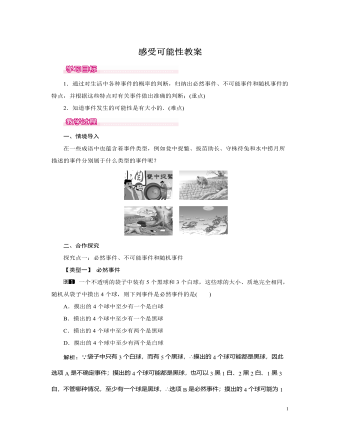
北师大初中七年级数学下册感受可能性教案
一个不透明的袋子中装有5个黑球和3个白球,这些球的大小、质地完全相同,随机从袋子中摸出4个球,则下列事件是必然事件的是( )A.摸出的4个球中至少有一个是白球B.摸出的4个球中至少有一个是黑球C.摸出的4个球中至少有两个是黑球D.摸出的4个球中至少有两个是白球解析:∵袋子中只有3个白球,而有5个黑球,∴摸出的4个球可能都是黑球,因此选项A是不确定事件;摸出的4个球可能都是黑球,也可以3黑1白、2黑2白、1黑3白,不管哪种情况,至少有一个球是黑球,∴选项B是必然事件;摸出的4个球可能为1黑3白,∴选项C是不确定事件;摸出的4个球可能都是黑球或1白3黑,∴选项D是不确定事件.故选B.方法总结:事件类型的判断首先要判断该事件发生与否是不是确定的.若是确定的,再判断其是必然发生的(必然事件),还是必然不发生的(不可能事件).若是不确定的,则该事件是不确定事件.





















